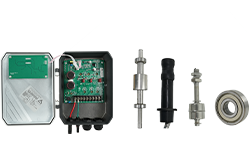DIFFUL SOLAR PUMP - - Demand analysis of photovoltaic
PV demand is divided into two stages
1. The stage of subsidy impact
From the introduction of photovoltaic subsidies in Germany in the last century to the global flat grid in 2019, fluctuations in demand in the photovoltaic market have come from subsidies. Subsidies come from government finances, and fluctuations in the business cycle affect photovoltaic demand. From a historical perspective, 2008, 2011 and 2018, when photovoltaic demand fluctuated greatly, corresponded to the US subprime mortgage crisis, the European debt crisis and China's deleveraging. Although each fluctuation only slows down the growth of photovoltaic demand, the more volatile supply knocks down the price, causing serious industry operating difficulties. The advantage is that each price drop promotes the rapid development of demand. The scale of photovoltaics has grown more than a hundredfold in the past ten years. After 2019, the impact of subsidies has gradually faded, and photovoltaic development has endogenous attributes and has entered the second stage.
2. Phases of grid connection
Photovoltaics have the economic and technical attributes to replace thermal power with parity. This means that the future economic cycle will have less and less impact on photovoltaics. However, if the price of solar storage cannot be parity, the growth rate of photovoltaic demand will gradually return to zero.
After 2019, the industry has entered the second stage of development. Photovoltaic is no longer a simple standardized product or system. The photovoltaic industry that has installed energy storage will welcome the dawn of freedom, and the industry ecology will become more and more abundant.
Source of demand
It is not just an energy storage device that has increased from photovoltaics to solar storage. The industry logic has also undergone revolutionary changes, further strengthening the logic from cost reduction to efficiency improvement. In the optical storage system, battery systems account for 50%, other BOS accounts for 30%, and photovoltaics account for 20%. That is to say, the space for greatly reducing the cost of photovoltaics is getting smaller and smaller, and the necessity is getting lower and lower. The system performance brought by the improvement of photovoltaic efficiency is doubled, because the larger the BOS, the higher the efficiency leverage of the system. On the other hand, the bulk of the cost reduction of the optical storage system lies in the battery system, which will change the competitive landscape of the iron-lithium route relative to the ternary route. In short, the solar storage system relies on photovoltaics to improve efficiency and relies on battery cost reduction. Therefore, in the subsidy phase, the logic of photovoltaic cost reduction is gradually weakened, and new technologies such as HIT may even realize the possibility of price increases to stimulate demand in the second stage of getting rid of grid connection restrictions. For the first time, the technical attributes of photovoltaics surpassed the cost attributes, and the industry valuation is facing a systematic restoration.
We firmly believe that the replacement of thermal power by photovoltaics will be the most important change in the energy sector in the next ten years, and everything still starts with the next new technology
Please contact us for more details.
E-mail:sales08@diffulpump.com
Tel/WhatsApp:+86 15058288607
Facebook Twitter Google+ YouTube Linkedin























